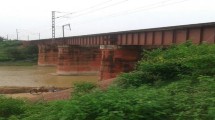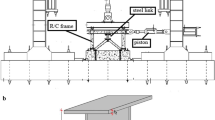Abstract
Major earthquakes of the last few decades have generated a great deal of interest in structural control systems, to mitigate seismic hazards to lifeline structures—in particular, bridges. The vast destruction and economic losses during earthquakes underscore the importance of finding more rational and substantiated solutions for protection of bridges. One of the most promising devices, considered as a structural control system, is a passive device. Although, there has been substantial work in the recent past in the development of seismic isolators and structural control systems, their effectiveness could not be compared by a systematic study, because they were applied to different types of structures subjected to different types of loadings. A benchmark problem on highway bridges has been developed to compare the performance and effectiveness of different control systems in protecting bridges from earthquakes. In the present study, seismic response of the Benchmark Highway Bridge , with passive controllers is investigated. The problem is based on the 91/5 highway over-crossing at Southern California, USA. In the first phase, the deck is fixed to the outriggers, and in the second phase, the deck is isolated from the outriggers. Using an analytical frame work, a thorough investigation of the isolation devices has been carried out to evaluate their effectiveness under different earthquakes. The response of the bridge to six different real earthquake ground excitations is investigated using simplified lumped mass finite element model of the bridge. The optimum device parameters are investigated to improve response of the benchmark highway bridge. The study explores the use of seismic isolators, namely, Friction Pendulum System (FPS), Double Concave Friction Pendulum System (DCFPS), Variable Friction Pendulum System (VFPS) and Variable Frequency Pendulum Isolator (VFPI). The governing equations of motion are solved by Newmark-beta solver in MATLAB and SIMULINK toolbox. The effectiveness of the devices is explored in terms of reduction of the specified evaluation criteria, considering maximum and norm values. The analytical simulation results demonstrate that these isolators, under optimum parameters are quite effective and can be practically implemented for the vibration control of bridges.
Access this chapter
Tax calculation will be finalised at checkout
Purchases are for personal use only
Similar content being viewed by others
References
Agrawal AK, Tan P (2005) Benchmark structural control problem for a seismically excited highway bridge, Part II: Sample control designs. http://www-ce.engr.ccny.cuny.edu/People/Agrawal
Constantinou MC, Mokha AS, Reinhorn AM (1990) Teflon bearings in base isolation II: modeling. J Struct Eng (ASCE) 116:455–474
Fenz DM, Constantinou MC (2006) Behaviour of the double concave friction pendulum bearing. Earthq Eng Struct Dynam 35:1403–1424
Jangid RS (2005) Optimum friction pendulum system for near-fault motions. Eng Struct 27:349–359
Kim Y-S, Yun CB (2007) Seismic response characteristics of bridges using double concave friction pendulum bearings with tri-linear behavior. Eng Struct 29(11):3082–3093
Makris N, Zhang J (2002) Seismic response analysis of highway overcrossings including soil-structure interaction. Earthq Eng Struct Dynam 31(11):1967–1991
Nagarajaiah S, Sun X (2001) Base-isolated FCC building: impact response in Northridge earthquake. J Struct Eng ASCE 127:1063–1075
Panchal VR, Jangid RS (2008) Variable friction pendulum system for near-fault ground motions. Struct Control Health Monit 15:568–584
Pranesh M, Sinha R (2000) VFPI: an isolation device for aseismic design. Earthq Eng Struct Dynam 29(5):603–627
Tan P, Agrawal AK, Nagarajaiah S, Zhang J (2005) Benchmark structural control problem for a seismically excited highway bridge, Part II: Sample control designs. http://www-ce.engr.ccny.cuny.edu/People/Agrawal
Zayas VA, Low SS, Mahin SA (1990) A simple pendulum technique for achieving seismic isolation. Earthq Spectra 6(2):317–333
Agrawal A & Tan P (2009) “Benchmark structural control problem for a seismically excited highway bridge-Part II: phase I sample control designs”, Struct Control Health Monit 16:530–548
Constantinou MC (2004) Friction pendulum double concave bearing. State university New York. Buffelo
Author information
Authors and Affiliations
Corresponding author
Editor information
Editors and Affiliations
Rights and permissions
Copyright information
© 2015 Springer India
About this paper
Cite this paper
Madhekar, S.N. (2015). Seismic Performance of Benchmark Highway Bridge Installed with Passive Control Devices. In: Matsagar, V. (eds) Advances in Structural Engineering. Springer, New Delhi. https://doi.org/10.1007/978-81-322-2193-7_106
Download citation
DOI: https://doi.org/10.1007/978-81-322-2193-7_106
Published:
Publisher Name: Springer, New Delhi
Print ISBN: 978-81-322-2192-0
Online ISBN: 978-81-322-2193-7
eBook Packages: EngineeringEngineering (R0)




